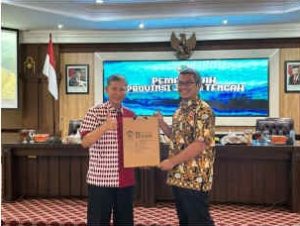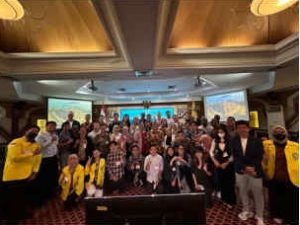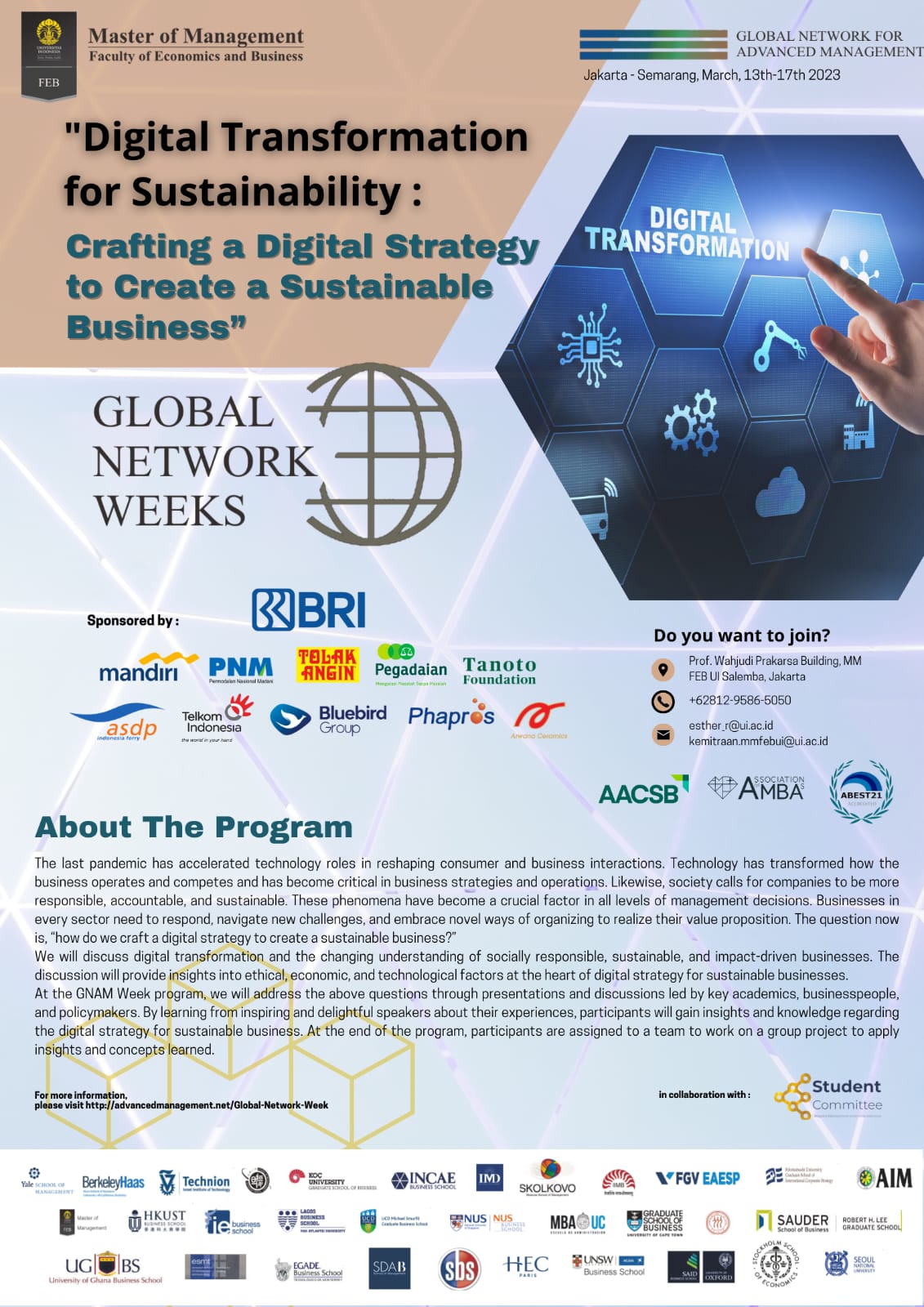GNAM Week Universitas Indonesia 3rd Day:
Visit to The Governor’s Office of Central Java and Diponegoro University
Recap of Day 3 Session 1 GNAM Week
Digital Government Transformation: Challenges and Opportunities.
On 3rd day the session starts with a visitation to the Governor’s Office of Central Java. Before the first session started, Mr. Arviansyah, Ph.D., gave the opening speech on behalf of MM FEB Universitas Indonesia. Then, followed by a welcoming speech from Mr. Dadang Sumantri ATD, MT. Head of Infrastructure and Natural Resources of Central Java Province
Mr. Dadang Sumantri, ATD, MT, provided the lecture material and was moderated by Mr. Arviansyah, Ph.D. Mr. Dadang mentioned how digital helps increase accessibility in meeting people’s needs. He explains how the government supports building digital culture in society 4.0
Digitalization in Central Java is part of the government’s vision and mission. It is stated as 2nd mission and becomes its primary program by reforming bureaucracy using IT and integrated systems. He said that the government must provide “easy” services and use digital technology as one of the central infrastructures that can support the idea.


Mr. Dadang mentioned that they have 3 cores in digitalization within government service. The first is direct public service. Examples of the implementations are through public services. Like licensing, vehicle tax, Lapak Ganjar, Blangkon Jateng, Big Data For vehicle tax services, convenience is provided through cashless payment. Also, with big data analytics, the government offers further safety by utilizing technological development.
Digitalization in Central Java helps to push SMEs’ (Small and Medium Enterprises) promotion and marketing. Lapak Ganjar has more than 3.5 million followers (Ganjar Social media) and is uploaded every week.Blankonjateng (Belanja langsung toko langsung Jawa Tengah or direct shop shopping Central Java ) is online store or marketplace that focus on in Central Java SMEs product. The government digitally monitors the business process, so the pricing offered is competitive.
The second point in core digitization is public communication. The example of implementation within the second point is Lapor Gub (Report to Governor): The way citizens directly report any inconvenience to the Governor of central java (whistleblow system). The reports proceeded directly to the domain/ related division. In 2020 there were 25074 reports submitted, and about 1047 people chose to stay anonymous with their reports.
The third point in core digitization is Bureaucracy Management. Central Java Government fulfilled that by digitizing all government-related activities with GRMS Jateng (Government Resource Management System of Central Java), which consists of SIPPD (Government Planning and Information System) – directly linked with the ministry of internal affairs, e-Budgeting, e-Project Planning, e-Controlling, e-Delivery, e-Penatausahaan, e-Monev, e-SHB, Governor Personal Handbook (GPH), e-Office In Indonesia, internet use touched 199,71 million (2020) from about a total population of 266 million, and about 170 million, or 61%, are active social media users. In Central Java, there are 26 million users from a total of 37,5 million population.
Based on data, 99,1% of access from the smartphone is by the demographic of 25-34 years old. Nowadays, ethics is the problem in digitalization, mostly about hoaxes (92,4 % of social media information is a hoax) and egoism. Mr. Dadang also talks about the importance of building digital culture due to that reason. So infrastructure, regulation, finances, tools, human resource, and data should be prepared.
Finally, he said that the solution should start with the culture. The correct digital culture can be built at the core of critical information distribution. The examples are economic information and COVID-19 during the pandemic situation because there are quite a lot overexaggerate of situation.

Recap of Day 3 Session 2 GNAM Week
Digital Transformation for Sustainability : Crafting a Digital Strategy to Create a Sustainable Business. Held in Semarang, March 15 th 2023
In the second session of Day 3, all participants visited Magister Management at Diponegoro University. The main session was moderated by Mrs. Yeshika Alversia, M.Sc, one of lectures from University of Indonesia. The speaker for this session was Dr. Daniel Lukito, S.T., M.M., M.Sc., IB., as a Business Transformation specialist, lecturer at Diponegoro University, co-Founder at many places, leadership trainer, consultant and business mentor. Mr. Daniel gave examples of failed company that faced disruption like IBM, Blackberry, Nokia, and Kodak Film. These company lost their market because couldn’t innovate digitally and couldn’t recognize the value of their service. He also said that disruption in business may not be as good from the original or existing offerings from company, but it’s more convenient and affordable for consumer. It can come from startups or from established companies. He said when disruption comes, you won’t see it coming. He gave an examples of a company that learned and took down the previous paradigm because of fear that the same situation would happen to them, they purchased shares from companies that had the potential to create a new paradigm, like Google purchasing Facebook, Facebook purchasing WhatsApp and Instagram. Digital transformation is conceptually defined as a process that aims to improve an entity by triggering significant changes to its properties through combinations of information, computing, communication, and connectivity technologies. He said that management needs to make sure that the company will live stronger and profitable.
Mr. Daniel said that not every company transforms their digital transformation successfully. In fact, the success ratio may be low, around 4% to 11%, 11% is for companies that already use digital technologies in their daily activities, and 4% is for industries that are more traditional. International corporation managers must have the best team, they must be well-educated, informed, trained, but many of them still fail. This happens because of they don’t have the experience to face the disruption. They have no idea how to transform from an embryo to a giant and don’t expected crisis.
Leadership is a part of management and is really essential. When leaders don’t have sufficient skills, they will face difficulties when they have to finish the project. Management, psycology, and communication are three things that leadership must have internally and externally. It’s a complex job because they need to face changes brought about by disruption. It needs to be implemented quickly throughout the organization. Leader will face many resistances. Digital strategy is a complex things. It’s just a small part, so companies have to learn and master it. Digital technology is just a tool to achive business strategy, it’s not a strategy.
Mr. Daniel introduced the ORIGIN framework that was developed to guide management practitioners preaparing for digital transformation journey. There are five stages in this framework. The first stage is opportunity and risk indentification using SWOT analysis. Many factors can be a streghth, weakness, threat or opportunity. The second stage is intentions, which is when we want to put scores and we select the outcomes from many achievement possibilities. He gave an example of effect analysis, why does every company need a vision statement, it is because the sources are limited, so we need to choose the most important tools and organize them to achieve the vision. The third stage is gap management, which is when we need to have some condition to make a digital vision statement, compare it with our current condition, and make strategic executable plans to fill the gap. The fourth stage is involvement. Who should do what and when. There are three steps of change from Lewin’s : unfreeze, change/transform and refreeze moments, where there are different roles from top management, middle management and low/staff management. Last stage is nurturing DIMES (Deploy, Implement, Monitor, Evaluate and Adjust, Support). The company needs to adjust based on what really happens. After the five stages, top management must look for another opportunity.

